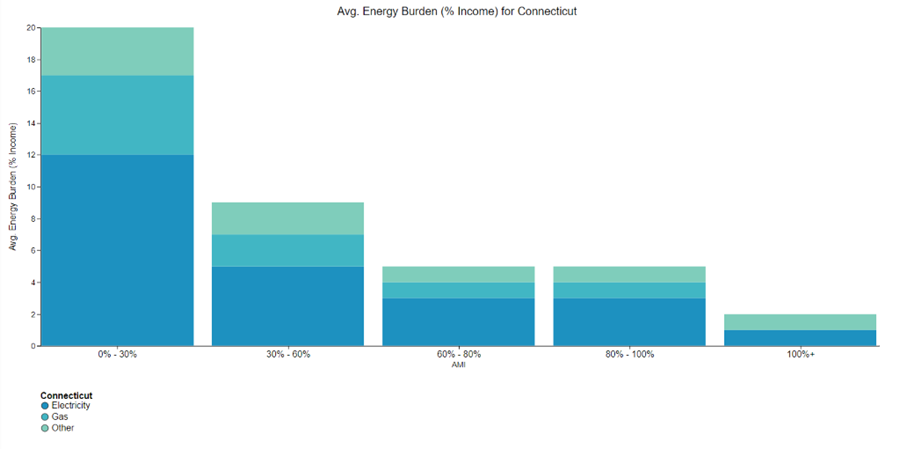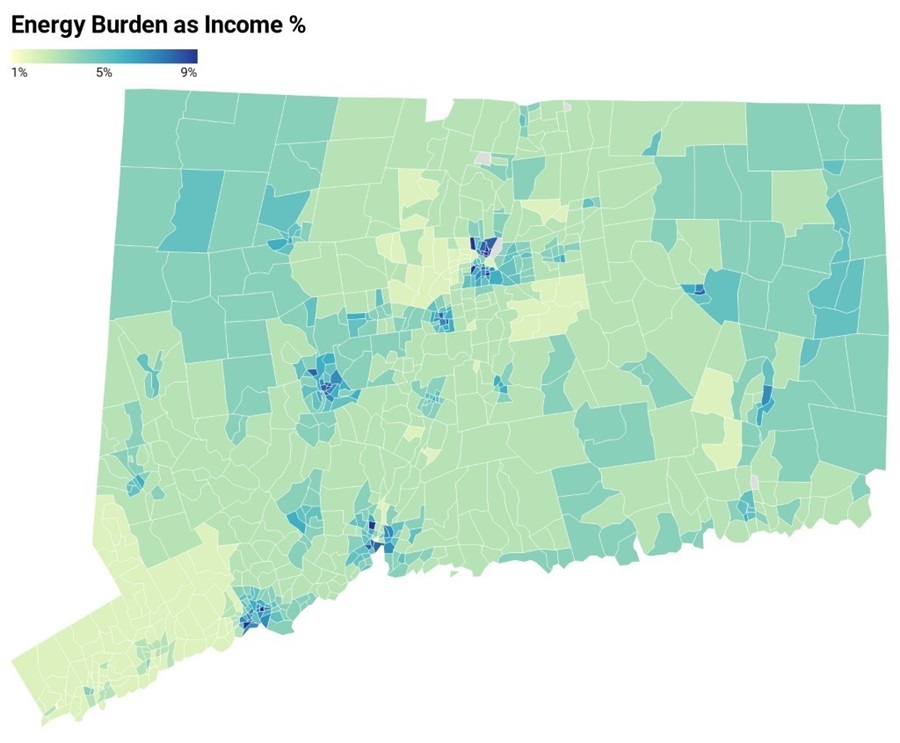Senate Bill 882, An Act Concerning Climate Change Mitigation and Home Energy Affordability
Climate change continues to accelerate and is increasingly impacting the residents and businesses of Connecticut. Governor Lamont recognizes the threat it poses and proposes taking proactive measures to accelerate the achievement of net-zero carbon emissions in the state’s electric sector and to give homeowners, renters, and landlords the tools they need to reduce energy usage at home and to budget for that usage. Those tools will be particularly important for our low-income residents who currently spend 20% of their income on energy bills.
Information about Senate Bill 882.
The Problem
Connecticut needs a target: a date by which the state will no longer have to rely on natural gas and oil to power its electric grid. While Connecticut has already made significant progress in decarbonizing its grid, we must accelerate this process to ensure our efforts to electrify the rest of the economy are making as much progress on reducing emissions as possible. And investments in zero carbon electricity generation will support clean energy jobs across the state.
Connecticut consumers also need information. Energy bills are a significant burden on working families across the state, with households between 0-30% of Area Median Income spending 20% of their income on energy bills and households between 30-60% spending 9%. Those burdens have been increased during the COVID-19 pandemic and associated economic downturn, which have forced consumers into more than $600 million of utility arrears. They are particularly severe for renters, who are more likely to be part of our black or brown communities, have no way of approximating their energy costs in a new apartment, and have few opportunities or incentives to invest in even the small renovations that make an apartment much more efficient. Although you would never buy a car without knowing its miles per gallon, we leave our residents no choice but to rent or buy a home without know whether they can heat it on their family’s budget.

Governor Lamont’s Solution
Electric Sector Decarbonization
Through direct investment in the form of long-term contracts, Connecticut ratepayers are currently supporting over 600,000 MWh/year of operating grid-scale, zero-emission renewables and more than 9 million MWh/year of zero-carbon nuclear resources, equivalent to nearly 65 percent of the electricity consumed by customers of the state’s two EDCs. By 2025, that percentage is expected to increase to 91 percent, or 24.5 million MWh/year, as new offshore wind and grid-scale solar projects that have been contracted but not constructed will come online.
Governor Lamont and his administration believe that the state of technology for carbon neutral electricity generation is evolving quickly. DEEP documents many of these technological improvements in its various annual reports. Given the state of technology improvement, a 2040 target for a carbon neutral electricity supply is an achievable target. The IRP modeling demonstrated that the goal is achievable with existing technology. The resources procured in Section 2, energy efficiency and demand response, have the ability to perform in all hours of the day, are a companion piece to this target to help balance increasingly high penetration of intermittent, zero carbon resources such as wind and solar, so we can accelerate our transition away from oil and natural gas generation. Active demand response measures provide electric customers the ability to help reduce load at peak times and benefit financially in doing so.
The proposal codifies into statute a goal stated in Governor Lamont’s Executive Order No. 3 and included as a recommendation in the Draft Integrated Resource Plan (IRP). The modeling in the IRP demonstrated that there are a variety of available pathways to achieving the goal. Many of our peer states have, or are expected to, adopt similar goals. These states include California, Hawaii, Maine, New Mexico, Nevada, New York, Washington, and Rhode Island, along with D.C.
Critically, the goal provides official direction to DEEP, PURA, the electric utilities, the municipal utilities, and others in planning and implementing energy policy. It places Connecticut at the forefront of addressing climate change and positions the state to serve as a model for other states that will be ramping up their efforts to tackle this critical issue in the coming years.
The proposal allows the Department of Energy and Environmental Protection (DEEP) to procure up to 300,000 MWh of electricity (equivalent to approximately 1% of Connecticut’s load) from active demand response measures and passive demand response measures. These resources are necessary to provide stability and reliability to the electric grid in all hours of the day as we increase the deployment of intermittent resources such as wind and solar.
Home Energy Affordability
Governor Lamont proposes helping consumers reduce energy use and arming our most vulnerable residents with the information they need to make affordable choices. Under his proposal, property owners listing homes for sale or lease will provide prospective buyers and tenants with either a Home Energy Label – a number generated during a home energy audit that summarizes the property’s energy efficiency – or the last twelve months of energy bills, which energy companies will begin disclosing to property owners who need them. Affordability and efficiency begin with transparency into costs and opportunities to reduce them.
The average single-family home in Connecticut spends about $3,600 in energy costs, the second-highest in the nation.That affordability challenge is more pronounced for Connecticut’s low-income households, who spend as much as 20% of their income on energy costs. Inability to pay can lead to utility shutoffs, which are one of the primary causes of homelessness nationwide. Unpaid billsalso lead to higher rates for all ratepayers. As the below map shows, affordability challenges are heavily concentrated in communities with access to fewer resources.Providing residents with approximate energy costs up front would not only improve their ability to budget but also help steer residents to more efficient homes with energy costs they can afford and encourage landlords and sellers to invest in efficiency improvements.

Energy labeling and disclosure policies have demonstrated positive impacts on home sales. In other jurisdictions, homes that disclosed energy costs, even when costs were high, spent less time on the market and closed at a higher percentage of asking price than homes that did not disclose this information. At the same time, these policies make energy efficiency information transparent and accessible to both buyers and sellers, thereby allowing it to be accurately valued by the real estate market. National surveys have consistently demonstrated that energy efficiency is a major factor in home buyers’ decision making, and studies have shown that energy efficient features are a selling point for homes.
This proposal also presents an opportunity to further develop Connecticut’s energy efficiency workforce. There are currently over 80 certified Home Energy Score assessors in the state, and this proposal would create demand for even more. Additionally, the Home Energy Score report provides a list of recommended cost-effective upgrades to improve a home’s efficiency. Following through on these upgrades supports Connecticut’s energy efficiency workforce, which is the largest employer in the state’s clean energy sector.
By making energy consumption more transparent, this proposal would help Connecticut better understand and reduce residential energy consumption, support the state’s energy efficiency workforce, and give home buyers and renters the information they need as they make some of the most important financial decisions of their lives.
Landlords and property owners who choose to comply with energy disclosure requirements by providing a U.S. Department of Energy Home Energy Score can obtain a score easily and affordably through Connecticut’s Home Energy Solutions program. Similar to a car’s mile-per-gallon rating, the Home Energy Score rates a home on a scale of 1-10 based on characteristics like floor area, insulation, windows, and energy systems. Home Energy Scores do not account for resident behavior, allowing for an “apples to apples” comparison of similar home types.
In addition to creating better-informed consumers, this proposal also aligns with other state policy objectives and priorities. The Governor’s Council on Climate Change has identified the building sector as a major source of GHG emissions and recommended training real estate professionals to integrate Home Energy Scores into real estate transactions and processes in their 2021 Phase 1 report. Energy disclosure requirements would also support the statutory goal of weatherizing 80 percent of Connecticut homes by 2030.
Several cities and states, including Alaska, Hawaii, Kansas, Maine, New York, and South Dakota have some form of residential energy disclosure policy. Portland, Oregon adopted a disclosure policy similar to this proposal in 2018 and has successfully incorporated labeling into real estate transactions with minimal disruption to the market.

